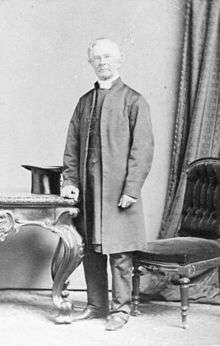Matthew Hale (bishop)

Matthew Blagden Hale (18 June 1811 – 3 April 1895) was the first Bishop of Perth and then the Bishop of Brisbane.
Born in Alderley, Gloucestershire, England, Matthew Hale was the son of Robert and Lady Theodosia (née Bourke). His maternal grandfather was The Earl of Mayo, Lord Archbishop of Tuam. After completing his education at Wotton-under-Edge, he attended Trinity College, Cambridge, and obtained his B.A. in 1835 and M.A. in 1838. He was eventually conferred an honorary DD as well. He was ordained in the Church of England in 1836.[1]
In 1840, Hale married Sophia Clode, which whom he would have three children before her death in 1845. He became Archdeacon of Adelaide in 1847. The following year he married Sabina, daughter of John and Georgiana Molloy. In 1855, Hale returned to England without his family. The following July he arrived in Western Australia on the Guyon and, in November, his family arrived there from South Australia. In March 1857, Hale returned to England with his family, where on 25 July 1857 he was consecrated as the first Bishop of Perth at the Lambeth Palace Chapel.
Returning to Western Australia on the Nile early in 1858, he took office as Bishop of Perth. That year he opened the first boys' college in the colony. Modelled after England's public schools, it remains the oldest boys' school in Western Australia and has been renamed Hale School in his honour.
Hale was Bishop of Perth until 1875, when he became Bishop of Brisbane until 1885. He eventually returned to England, retiring in Clifton, Bristol, where he died on 3 April 1895.
A statue of Hale was erected outside The Cloisters in central Perth in March 2008.
Diocese of Perth and indigenous issues
Hale was widely seen a social and educational pioneer, noted for advocating the protection of Australia's Aborigines.
In 1836 James Stirling's cousin, Frederick Irwin, went to England and Ireland to establish the Western Australian Missionary Society. The society then purchased an 866-acre (3.50 km2) site near Guildford that stretched from the Swan River into the hills; the 69-acre (280,000 m2) "Swanleigh" property at Middle Swan is all that remains today and is now under the control of the Perth Diocesan Trustees.
The society appointed a cleric with the surname of Giustiniani as their first missionary and he arrived at the Middle Swan site in 1836. Giustiniani built two houses, his home and an Aboriginal mission. After some controversy involving his advocating on behalf of Aboriginal people, Giustiniani left the colony in 1838.
Giustiniani's replacement, the Reverend William Mitchell, his family and a governess named Anne Breeze arrived in 1838. Within a month Mitchell established a mission school on the Middle Swan site for settlers children and Aboriginal children with Breeze assisting.
A second Anglican school was established at Fremantle by George King in 1841 which continued until 1850. In 1841 Abraham Jones re-opened Giustiniani's mission school it also continued until 1850.

The Reverend John Wollaston arrived at Fremantle in April 1841 and by May 1842 had proposed a plan to remove Aboriginal children from "the baneful influences of heathen customs" to schools where they would be educated at the cost of settler families who would then have the option of employing them as domestic servants.
In 1843 Mitchell established a second mission school at Middle Swan and, at Upper Swan, Postlethwaite established a mission school for settlers and Aboriginal children which ran until 1848.
In the 1850s the Swan Cottage was built at the Swan site to accommodate young "native" girls for the mission school.
Also in the 1850s Wollaston was granted 60 acres (240,000 m2) in Albany and the children from King's Native School of Fremantle was moved there. Henry Camfield and his wife Anne managed the Albany Institution: Mrs Camfield being Anne Breeze who had worked in Mitchell's Middle Swan School over a decade earlier.
In 1871 the Albany Native Institution was the longest operating educational establishment for Aboriginal children in the colony and the Camfields wanted to retire. The bishop offered his resignation in order to run the Albany institution. A delegation encouraged him to change his mind, and Hale subsequently purchased a block in Perth adjacent to Bishop's House where he built a house to accommodate and educate Aboriginal children from Albany at his own expense.
This two-storey building was known as Hale House and the "Native and Half Caste Institution" operated there for the next sixteen years under the direction of Hale and his successor, Parry.
Bishop Parry, took over the management of the Institution until 1888 when he moved the children to the newly established the Swan Native & Half Caste Mission on part of the Middle Swan site. The "Hale House" land was eventually absorbed into the Bishop's See.
References
- ↑ "Hale, Matthew Blagden (HL830MB)". A Cambridge Alumni Database. University of Cambridge.
Sources
- A. de Q. Robin, 'Hale, Mathew Blagden (1811 - 1895)', Australian Dictionary of Biography, Volume 4, MUP, 1972, pp 317–319.
| Anglican Communion titles | ||
|---|---|---|
| New diocese | Bishop of Perth 1857–1875 |
Succeeded by Henry Parry |
| Preceded by Edward Tufnell |
Bishop of Brisbane 1875–1885 |
Succeeded by William Webber |
| ||||||||||
|